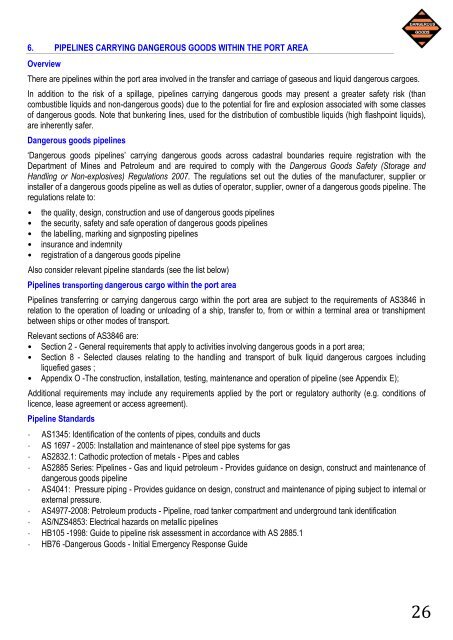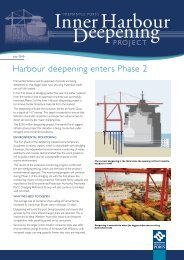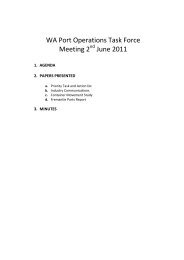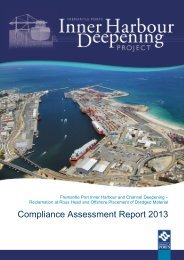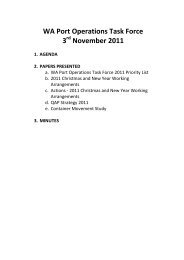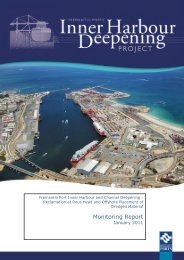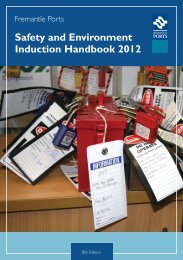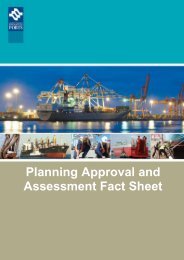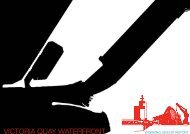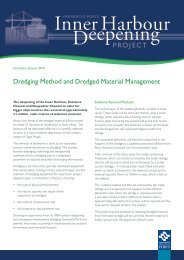Dangerous Cargoes Standard - Fremantle Ports
Dangerous Cargoes Standard - Fremantle Ports
Dangerous Cargoes Standard - Fremantle Ports
- No tags were found...
You also want an ePaper? Increase the reach of your titles
YUMPU automatically turns print PDFs into web optimized ePapers that Google loves.
6. PIPELINES CARRYING DANGEROUS GOODS WITHIN THE PORT AREAOverviewThere are pipelines within the port area involved in the transfer and carriage of gaseous and liquid dangerous cargoes.In addition to the risk of a spillage, pipelines carrying dangerous goods may present a greater safety risk (thancombustible liquids and non-dangerous goods) due to the potential for fire and explosion associated with some classesof dangerous goods. Note that bunkering lines, used for the distribution of combustible liquids (high flashpoint liquids),are inherently safer.<strong>Dangerous</strong> goods pipelines„<strong>Dangerous</strong> goods pipelines‟ carrying dangerous goods across cadastral boundaries require registration with theDepartment of Mines and Petroleum and are required to comply with the <strong>Dangerous</strong> Goods Safety (Storage andHandling or Non-explosives) Regulations 2007. The regulations set out the duties of the manufacturer, supplier orinstaller of a dangerous goods pipeline as well as duties of operator, supplier, owner of a dangerous goods pipeline. Theregulations relate to:• the quality, design, construction and use of dangerous goods pipelines• the security, safety and safe operation of dangerous goods pipelines• the labelling, marking and signposting pipelines• insurance and indemnity• registration of a dangerous goods pipelineAlso consider relevant pipeline standards (see the list below)Pipelines transporting dangerous cargo within the port areaPipelines transferring or carrying dangerous cargo within the port area are subject to the requirements of AS3846 inrelation to the operation of loading or unloading of a ship, transfer to, from or within a terminal area or transhipmentbetween ships or other modes of transport.Relevant sections of AS3846 are:• Section 2 - General requirements that apply to activities involving dangerous goods in a port area;• Section 8 - Selected clauses relating to the handling and transport of bulk liquid dangerous cargoes includingliquefied gases ;• Appendix O -The construction, installation, testing, maintenance and operation of pipeline (see Appendix E);Additional requirements may include any requirements applied by the port or regulatory authority (e.g. conditions oflicence, lease agreement or access agreement).Pipeline <strong>Standard</strong>sAS1345: Identification of the contents of pipes, conduits and ductsAS 1697 - 2005: Installation and maintenance of steel pipe systems for gasAS2832.1: Cathodic protection of metals - Pipes and cablesAS2885 Series: Pipelines - Gas and liquid petroleum - Provides guidance on design, construct and maintenance ofdangerous goods pipelineAS4041: Pressure piping - Provides guidance on design, construct and maintenance of piping subject to internal orexternal pressure.AS4977-2008: Petroleum products - Pipeline, road tanker compartment and underground tank identificationAS/NZS4853: Electrical hazards on metallic pipelinesHB105 -1998: Guide to pipeline risk assessment in accordance with AS 2885.1HB76 -<strong>Dangerous</strong> Goods - Initial Emergency Response Guide26


